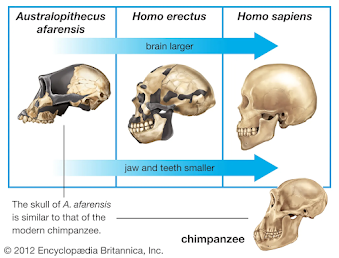Evolution and Natural Selection
1. What is a Theory?
Theory: An explanation supported by scientific evidence; Can be changed!
Law: Describes a phenomenon; Math can be used to show this law. NEVER CHANGED!
2. Theory of Evolution
3. What is Evolution?
4. Is there Evidence of Evolution?
Fossils
Fossils can appear in rocks, ice, and amber. When fossils are arranged in order of their age, the fossil record provides a series of changes that occurred over time.
Gives evidence of a common ancestor
Hominid Evolution
- Bipedalism (walk on two legs)
- Increase in Brain Size
- Smaller teeth and jaw
- Uses Tools
- Can talk in a Language
Molecular Biology
Comparing DNA/ gene or protein sequences from organisms.
Closely Related organisms will have similar DNA, RNA, and protein sequences.
Gives evidence of a common ancestor
Embryology
Embryos of different vertebrates look alike in their early stages, giving the superficial appearance of a relationship. Gives evidence of a common ancestor.
Biogeography
Patterns of past evolution are found in the natural geographic distribution of related species, and the similarity of endemic island species to nearby mainland species.
5. Conditions required for Natural Selection
- There is variation in traits
- There is differential reproduction
- There is heredity
6. Mechanism of Evolutionary Change
Mutation
The change in DNA.
Since all cells in our body contain DNA, there are lots of places for mutations to occur.
However, not all mutations matter for evolution.
Somatic mutations: Occur in non-reproductive cells and won't be passed onto offspring
Only mutation in gametes can be passed on to offspring.
Gene Flow/ Migration
Any movement of genes from one population to another.
It includes different kinds of events, like pollen blowing to a new destination or people moving.
If genes are carried to a population (where those genes previously didn't exist), gene flow can be an important source of genetic variation which could lead to evolution in that population.
Genetic Drift
In each generation, some individuals may have the chance to leave more descendants (and genes) than others.
Example: Someone stepping on the green bugs and leaving only one alive.
Genes in the next generation will be those will be those of the "lucky" ones, not necessarily the healthier ones.
Nonrandom Mating
Mating that has not occurred due to chance.
Example: The bird in the video must do its very best to score with a mate!












